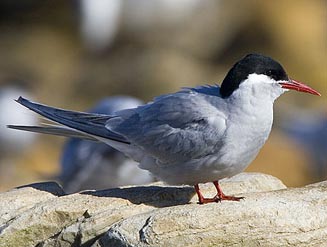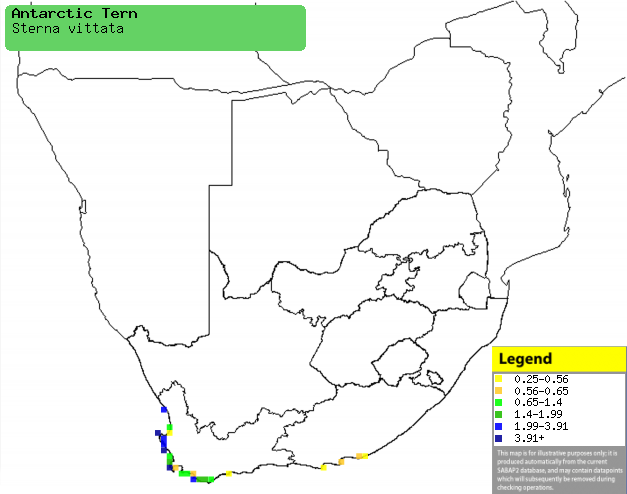|
Sterna vittata (Antarctic tern)
Grysborssterretjie [Afrikaans]; Antarctische stern,
zuidpoolstern [Dutch]; Sterne couronnée [French];
Gabelschwanz-Seeschwalbe [German]; Gaivina-antárctica [Portuguese]
Life
> Eukaryotes >
Opisthokonta
> Metazoa (animals) >
Bilateria >
Deuterostomia > Chordata >
Craniata > Vertebrata (vertebrates) > Gnathostomata (jawed
vertebrates) > Teleostomi (teleost fish) > Osteichthyes (bony fish) > Class:
Sarcopterygii (lobe-finned
fish) > Stegocephalia (terrestrial
vertebrates) > Tetrapoda
(four-legged vertebrates) > Reptiliomorpha > Amniota >
Reptilia (reptiles) >
Romeriida > Diapsida > Archosauromorpha > Archosauria >
Dinosauria
(dinosaurs) > Saurischia > Theropoda (bipedal predatory dinosaurs) >
Coelurosauria > Maniraptora > Aves
(birds) > Order: Charadriiformes
> Family: Laridae > Genus: Sterna
 |
 |
|
Antarctic tern in non-breeding plumage,
Jacobsbaai, South Africa. [photo Trevor Hardaker ©] |
Antarctic tern in breeding plumage, Cape Recife,
South Africa. [photo
Johann Grobbelaar ©] |
Distribution and habitat
Breeds on the Subantarctic Islands and Antarctic Peninsula,
mainly staying in the southern Ocean in the non-breeding season, although some
birds head north to southern Africa. Here it is locally fairly common along the
coast of the Western Cape, while more scarce in the Eastern Cape, spending most
of its time at sea before returning to rocky offshore islands to roost.
|
 |
|
Distribution of Antarctic tern in southern Africa,
based on statistical smoothing of the records from first SA Bird Atlas
Project (©
Animal Demography unit, University of
Cape Town; smoothing by Birgit Erni and Francesca Little). Colours range
from dark blue (most common) through to yellow (least common).
See here for the latest distribution
from the SABAP2. |
Movements and migrations
It is thought that the populations breeding in
the South Atlantic Ocean spend the non-breeding season in South
Africa, arriving in May and leaving in October.
Food
Mainly eats shoaling fish, such as Anchovies (Engraulis
encrasicolus), as well as krill (Euphausia), doing most of its
foraging by grabbing prey from the water surface or plunge-diving into
calm water.
Threats
Not threatened, although visitor numbers to the Western
Cape have considerably decreased since the 1980s while numbers in the Eastern
Cape are increasing, the cause of which is unknown.
References
-
Hockey PAR, Dean WRJ and Ryan PG 2005. Roberts
- Birds of southern Africa, VIIth ed. The Trustees of the John Voelcker
Bird Book Fund, Cape Town.
|
